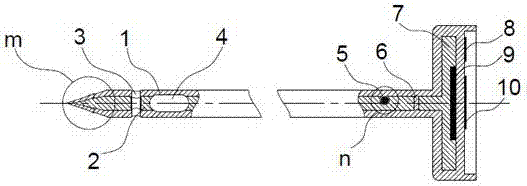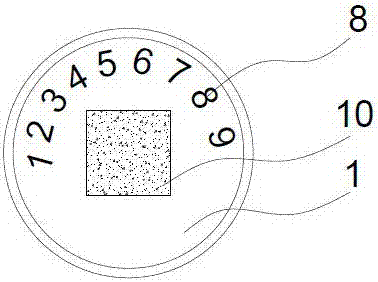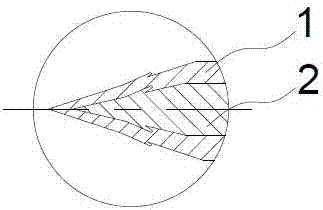Traceable device carrying fish biological information
A biological information and fish technology, applied in the field of artificial markers, can solve problems such as damage, marker falling off, affecting the actual function of line markers, etc., and achieve the effect of convenient operation and reasonable design
- Summary
- Abstract
- Description
- Claims
- Application Information
AI Technical Summary
Problems solved by technology
Method used
Image
Examples
Embodiment 1
[0022] Such as Figure 1-4 As shown, a traceable device carrying fish biological information includes a mark pole 2, a mark cap 7 connected to the mark pole 2, the mark pole 2 and the mark cap 7 are metal rods and metal caps, and the length of the mark pole 2 is the mark cap 7 5 times the diameter, the pole 2 at the junction of the pole 2 and the cap 7 is provided with a break hole 6, the distance from the break hole 6 to the cap 7 is 1 / 5 of the total length of the pole 2, and the front end of the pole 2 is a tapered head, The taper of the conical head at the front end of the pole 2 is 38°. The design of the conical head is beneficial to reduce the resistance of the marking machine or when it is inserted into the fish body, and can quickly push the pole 2 into the fish body completely. There are also barbs on the surface, the angle between the barbs and the conical head is 8°, the surface of the benchmark 2 is also provided with uniform through holes 3, the diameter ratio of t...
Embodiment 2
[0026] Such as Figure 1-4As shown, a traceable device carrying fish biological information includes a mark pole 2, a mark cap 7 connected with the mark pole 2, the mark pole 2 and the mark cap 7 are metal rods and metal caps, and the length of the mark pole 2 is preferably the mark cap 7 is 6 times of the diameter, which is conducive to the effective fixing of the benchmark rod 2 in the fish body, and avoids the situation that the benchmark rod 2 is too short and the standard cap 7 is too large to cause the traceability device to fall off easily. The break hole 6, the distance from the break hole 6 to the mark cap 7 is preferably 4 / 15 of the total length of the mark pole 2. The designed break hole 6 can break the end part of the mark pole 2 during the pulling process, so as to avoid fish pulling the mark pole when pulling aquatic plants. 2. Excessive mechanical damage is caused to the fish. The front end of the pole 2 is a conical head. The taper of the conical head at the fr...
Embodiment 3
[0029] When the device is actually working: First, the device is used to track many fish, such as large yellow croaker, dolphin, tuna, etc. After the researchers catch the target to be marked, they will collect biological information, and the collected biological information data can be input into the electronic In the chip 9, in order to carry out biological information comparison and research when the target is captured next time, after the data input of the electronic chip 9 is completed, the device is placed in the tissue of the dorsal fin and tail of the target by a marking machine or manually, and the placement position should be according to the target. The structure of the object chooses the position with the least damage. The pole 2 of this device is similar to a metal wire inserted into the fish body, which will cause little muscle damage when the fish swims. When the device is placed into the target, the cone at the front end of the pole 2 will The barbs on the head ...
PUM
| Property | Measurement | Unit |
|---|---|---|
| Thickness | aaaaa | aaaaa |
Abstract
Description
Claims
Application Information
 Login to View More
Login to View More - R&D
- Intellectual Property
- Life Sciences
- Materials
- Tech Scout
- Unparalleled Data Quality
- Higher Quality Content
- 60% Fewer Hallucinations
Browse by: Latest US Patents, China's latest patents, Technical Efficacy Thesaurus, Application Domain, Technology Topic, Popular Technical Reports.
© 2025 PatSnap. All rights reserved.Legal|Privacy policy|Modern Slavery Act Transparency Statement|Sitemap|About US| Contact US: help@patsnap.com



